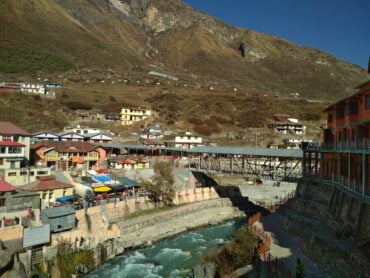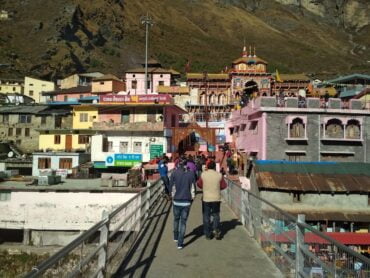History
In the 9th century, the holy town of Badrinath was re-established by Adi Guru Shankaracharya. In the olden days, pilgrims used to walk hundreds of miles to pray in the Badrinath Temple. During the 1st world War, there were only a few huts, where temple staff lived.
Architecture of Badrinath
The facing side of the temple is made up of stone and has arched windows. To enter the Badrinath temple you have to climb up the front stairs of the temple which starts from Tapt Kund(Hot water spring). Tapt Kund is a holy water source, it is believed that the water comes from the feet of Bhagwan Badri Vishal. These stairs are the main entrance of the Temple. But today as I’m talking about this year the Uttarakhand government is redesigning the temple corridor and now the whole area design is changed.
The temple is approximately 50 feet tall, and the roof of the Badrinath temple is covered with a gold gilded roof. Inside the temple, one can see the meditative posture of Lord Vishnu.
Mythology about Badrinath
There are two stories about Badrinath, the first one states that as per the Vamana Purana the two sages Nar & Narayana performed their penance here & Bhakt Narada was able to attain salvation.
The other story tells that Lord Vishnu in his childhood avatar came near the Neelkanth Parvat. At that time, they were searching for a peaceful place for meditation. While searching for the place, they fell in love with the site near the Alaknanda River. After that, they lived there for meditation and after that, the place was named Badri Vishal.
Badrinath is one of the most popular religious places in Uttarakhand and all over India. Badrinath is located in the Chamoli district of Uttarakhand state in India. The Badrinath town is situated in between Nar & Narayana mountains and in the shadow of the Neelkantha Peak. Bheem Pul and Vasudhara are also located near Badrinath they are also awesome places for travel and peace.
The origin of river Alaknanda
There is another great legendary tale, which is associated with Badrinath. Legends say that the holiest and curse reliever, the river the Ganga had granted the request of Bhgiratha for relieving humanity from curse sufferings. While ascending to earth, the intensity of the Ganga could immerse the earth under its water flow. To release the earth from the such force, Lord Shiva bore her onto his tresses and ultimately, the river Ganga got divided into twelve holy rivers and river Alaknanda was one of them.
Travel Guide Badrinath – How to reach Badrinath
If you are an individual and wanna travel alone to Badrinath Dham, then it’s not a big task to travel there. Badrinath is located at the roadside and the only thing you need to know is how to reach Badrinath. So here is the travel guide to Badrinath so that you can reach it easily.
Start Day 0: Reach Rishikesh, Haridwar, or Dehradun
As you know that Badrinath is located in Uttarakhand, so you need to reach the state first. If you are traveling by train you can only reach Rishikesh, Haridwar and Dehradun. Because after these stations there is no facility for trains. The nearest railway station to Badrinath is Rishikesh. After that, you have to travel by road by bus services and other vehicles.
If you want to travel by flight, firstly you need to travel to the Jolly Grant Airport Dehradun, and then you have to book a Helicopter service which will drop you at the Gaucher Airport. The ticket price from Dehradun to Gauchar is approx 5000 rupees. If you want to travel via road, you will have to take a Bus from Rishikesh, Haridwar and Dehradun. If you live in Delhi, you can pick up the Bus from Kashmiri Gate Bus Stand, Delhi to Karanprayag or Joshimath Chamoli.
Day 1: There are lots of Bus services and van services you can find at Rishikesh Bus Stand which operates to Badrinath. If you are a bike rider, you can also take bikes for rent from Rishikesh, which can make your journey more enjoyable. The route via road is about 295 Km from Rishikesh to Badrinath, and it takes approx 10 hours traveling time.
Route to Badrinath
Rishikesh – Devprayag – Srinagar – Rudraprayag – Karanprayag – Chamoli – Joshimath – Badrinath
Note: Due to 4 lane highway project work you can face travel delays of some hours but don’t worry you can stay in the above-discussed destinations like Srinagar which is also a big town of Uttarakhand, Rudraprayag, Gauchar, Karanprayag, Chamoli and then in Joshimath.
Day 2: When you reach Badrinath the next morning, wake up early and attend the morning aarti at the temple. It can take up to 2- 3 hours for Darshan because of the long queue of people. After that visit the nearest locations like Bhim Pul, Vasudhara Falls and then Mana village which is just 3 Km away from Badrinath. Mana is the last Indian village at the Indo – China border. You can also visit destinations such as Auli in Joshimath and the Valley of Flowers.
Day 3: After spending time at different places, you can return to your home via taxi service or bus service. Hope your journey will be great.
Activities you can do in Badrinath
As you visited all the nearby places, the extra activities you can do in Badrinath are:
Trekking: There are many treks that start from Badrinath such as Satopanth Trek, Mana Pass Trek and Charanpaduka Treks.
Village Tourism: Mana village, which is just only 3 Km away from Badrinath, is also known as the last Indian village. There is a very famous tea shop named “Antim Chai ki Dukaan”. Mana village is basically a village of Bhotias there are many shops there from where you can buy the famous spice “Faran” and handmade woolen sweaters, mufflers, and socks.
The basic clothing culture of the people who live there is “Pakhlu”. The peoples from Mana village sells their sweaters, spices(Faran mostly), woolen caps, woolen socks and other items in the different fairs like Gauchar Mela which is held in the month of November.
“Tapt Kund” is a natural hot spring that attracts people. The hot spring always remains as hot on Summer days as well as on Winter days. In winter, all the Badrinath and the nearby villages get covered with snow. There are some more locations such as Charanpaduka, Bheem Pul, Ganesha Cave, Panch Dharasand, Panch Shillas, Vyas Cave and Narad Kund.
Travel Tips for Badrinath
At an altitude of 3000 meters from sea level, the weather in Badrinath remains the same. It doesn’t matter in which month you are visiting, they always carry warm clothes together.
Please respect the holy place, and don’t carry alcohol and non-vegetarian food items.
Photography is prohibited inside the temple but is allowed outside and in other nearby places.
Traveling during the monsoon season is a little risky and the risk of landslides and road blockage is common at that time.
Highlights about Badrinath
Badrinath is one of the Panch Badris.
It is a part of the Char Dhams of Uttarakhand and India.
It is also known as Badrinarayan temple, which is one of the 108 Divya Dreams.
Badrinath Overview
- Temperature: 11(Max) and 3(Min)
- Location: Chamoli Garhwal
- Stay(Recommended): 2 Days
- Nearest Railway Station: Rishikesh, 295 Km
- Nearest Airport: Jolly Grant Airport, 314 Km
- Famous Locations: Badrinath Temple, Bheem Pul, Vasudhara Falls, Char Dham Yatra
- Best times to Visit: May, June, September and October
Frequently asked questions
What is the significance of Badrinath Temple?
Badrinath Temple is one of the four sacred shrines of Hinduism, known as Char Dham. It is believed that visiting Badrinath Temple and taking a dip in the Tapt Kund can wash away one’s sins and grant them salvation.
What is the best time to visit Badrinath Temple?
The Badrinath Temple is open for visitors from April to November. However, the best time to visit is between May and June and then from September to October when the weather is pleasant, and the temple is less crowded.
Can non-Hindus visit Badrinath Temple?
Yes, non-Hindus can visit Badrinath Temple, but they are not allowed to enter the sanctum sanctorum. They can visit other parts of the temple complex and witness the aarti and other rituals.
How do I reach Badrinath Temple?
Badrinath Temple is located in Uttarakhand, India. The nearest airport is in Dehradun, and the nearest railway station is in Rishikesh. From there, you can hire a taxi or take a bus to reach Badrinath. The last 3 km stretch needs to be covered on foot or by a pony.



